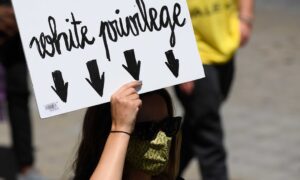

Commentary
Like “black criminality,” “Jewish shrewdness,” “Italian mafiosity,” and “Irish drunkenness,” “white fragility” is a racist concept.
Identifying a particular derogatory characteristic, or even a positive characteristic, with a racial or ethnic group, as if it accurately describes each and every individual in that category, is racist. Racism is treating people as members of racial or ethnic categories rather than as individuals with individual characteristics, motivations, and agency.
Wait, I know that radical sociologists and race activists have redefined “racism” as “prejudice plus power” in order to advance their Marxist political goals of dividing and conquering. In this arbitrary formulation, only whites can be racist, because allegedly only whites have power, and all whites have power. Similarly, the same suspects claim that “reverse racism” doesn’t exist, because only those with power can be racist, an assertion by definition but not supported by historical or empirical fact. This is a semantic trick that builds a desired conclusion into a definition.
“White fragility” is just one of a set of racist concepts celebrated by neo-Marxist “critical race theory,” some others being “white privilege,” “white nationalism,” and “white supremacism.” Other characteristics allegedly features of “whiteness” are heinous orientations such as individualism, looking for right answers, strong work ethic, belief in logic and science, postponement of gratification, competitiveness, and two-parent families.
This collectivist theory of racism is thanks to Marxism, which posits class conflict between economic oppressors and victims. The current neo-Marxism redefines class conflict in terms of identity politics, with racial, sex, and sexuality collective classes in conflict. In place of capitalists exploiting the proletariat, whites oppress blacks, men oppress women, and heterosexuals oppress LGBTQ++.
It’s a foundational assertion of critical race theory and “anti-racism” that all whites are racist. While no evidence is presented for this, logical tricks are central to “proving” it. Using logic along the lines of “heads I win, tails you lose,” and “have you stopped beating your wife?”, “white fragility” claims that denial of anti-black racism is a psychological weakness in whites who can’t tolerate the truth of their sins. So in terms of critical race theory, if you say, “yes, I’m racist,” you’re racist, and if you say “no, I’m not racist,” that proves you’re racist.
Perhaps it’s not surprising that critical race theory and anti-racism are reminiscent of witch hunters in the past who tested the accused by submerging them in a lake, or throwing them off a cliff into the ocean: If they floated, they were guilty, and then burned at the stake; while if they sunk, never to emerge, they were deemed innocent.
But, wait a minute, President Joe Biden and Vice President Kamala Harris recently said that they don’t believe that most Americans are racist. This is a major contradiction to critical race theory and the anti-racism instruction that in practice is anti-white instruction. If the president and vice president don’t think that most individual Americans are racist, why do they mandate and fund the teaching of critical race theory? The answer, according to the president, is that, while individual Americans aren’t racist, the country has “systemic racism.” What is this systemic racism without racist individuals?
Systemic racism turns out to be statistical disparities in education, employment, and income among different census categories of race and ethnicity. People from some categories are present in education, employment, and wealth at a level greater than their percentage of the general population, which is called “overrepresentation,” and some are present at a level less than their percentage of the general population, which is called “underrepresentation.” Systemic racism is deemed proven in cases in which blacks and Hispanics are statistically underrepresented, e.g., under the 13 percent which is blacks’ share of the general population in the United States.
The central argument of systemic racism is that statistical disparities among races are always and incontrovertibly the result of racial discrimination. This is the assertion upon which critical race theory and anti-racism stands or falls. The question that is rarely asked is whether there’s any evidence whatsoever to support it.
An example of racial disparities is highly paid professional sports, where black players are vastly overrepresented in relation to their 13 percent of the general population. In the National Football League in 2017, the percentage of black players was 64 percent; while in the National Basketball Association, the percentage of black players was 75 percent. According to the theory that statistical disparities are the result of discrimination, blacks must be highly overrepresented because there was discrimination against white and Asian players. The alternative explanation, never considered by advocates of systemic racism, is that blacks were more motivated and performed better. Does anyone really think that black athletes got their jobs because of discrimination?
Asians and Jews are highly overrepresented among college professors and medical doctors. According to the theory that statistical disparities are the result of discrimination, this overrepresentation in relation to their percentage in the general population must have happened because someone discriminated in their favor, and against other populations, such as blacks and Hispanics, who are underrepresented in these fields. Yet we know that, historically, both Asians and Jews faced discrimination against them, such as limits on the numbers admitted to universities and hospitals, rather than discrimination in their favor.
The critical race theory claim is that Asians and Jews are “privileged,” and have an unfair advantage over blacks and Hispanics. But, once again, we know from standardized tests and other objective criteria that Asians and Jews outperformed white Christians, Hispanics, and blacks. No “discrimination” is needed to account for these statistical disparities.
There are serious statistical disparities in education, referred to as the “racial achievement gap.” On average, Asian Americans are the highest achievers in education; whites are substantially behind; Hispanics are behind whites; blacks fall behind Hispanics. And while there’s no evidence that these differential results are the consequence of discrimination, “social justice” warriors denounce them as offenses to “equity,” which requires equal results across the categories. The plan is not to bring those performing poorly to a higher level of achievement, but to cancel the standardized tests and other measures of achievement, and to denounce achievement as a “white supremacist dog whistle.”
What accounts for differential achievement results is not discrimination, but disparities in family organization, with Asians having almost all two-parent families, and blacks having a large majority of one-parent, fatherless families. So too with community safety and security, with black communities having a high level of perpetrators of crime and victims of crime—almost half of all homicides and victims of homicide with only 13 percent of the population—while Asian communities have a low crime level. Community culture varies, with Asians having a high level of stress on education.
Critical race theory fails because its central argument, that statistical disparities are the result of discrimination, is not supported by evidence, and is therefore false. So too its racist attributions of “fragility” and “privilege,” which are not only false but also racist and despicable.
Philip Carl Salzman is professor emeritus of anthropology at McGill University, senior fellow at the Frontier Centre for Public Policy, fellow at the Middle East Forum, and president of Scholars for Peace in the Middle East.
Views expressed in this article are the opinions of the author and do not necessarily reflect the views of The Epoch Times.






Be the first to comment